Echium Pininana
The Echium Pininana, apart form never knowing quite how many n's there should be, is a bit of a strange plant. Growing rapidly from seed, the Echium pininana soon makes its presence felt in the garden.
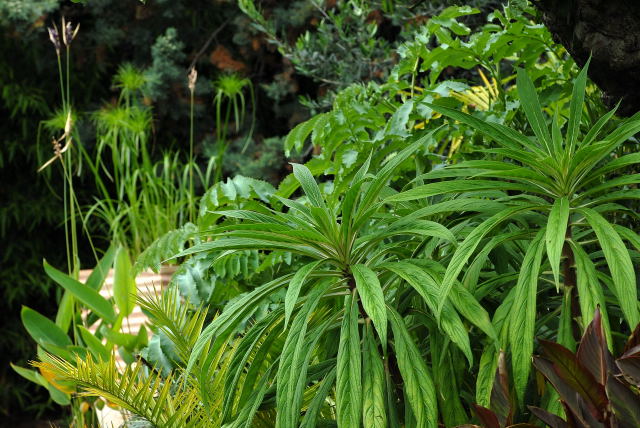
Echium Pininana
This plant is typically a biennial. The plant grows splendid large rosettes of slightly irritating leaves in the first year. This gives the Echium pininana as mentioned elsewhere a somewhat sinister appearance. Should the plant survive winter it will be in a bit of a state - scruffy and beleaguered- many of its leaves will have turned brown or fallen from the plant.
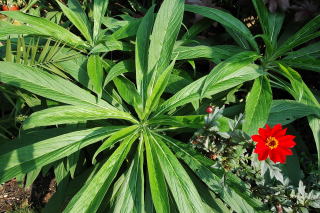
Echium Pininana enjoying October sunshine
Protecting the Echium pininana over winter is not an easy task. Often the plants will have grown several feet in height during their first summer. They will have quite a girth from their leaves. This makes wrapping with fleece impractical and unsightly, particularly if you have several plants. One or two nights at -4ºC will not bother the plant too much. If the plant is subjected to these temperatures night after night it simply gives up. Some winter protection for your echiums can be gained by planting them under trees.
Echiums don't always agree with where you think they should grow. Placing them at the rear of the border in the hope they
will grow upright will have your echiums crawling through the border only to poke out at the front. To get them to co-operate
fully and grow upright they want a spot that receives sun from different angles. Stick them in a corner and they will lean forwards
often
overbalancing.
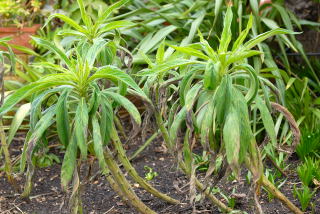
The same plants after the toil of winter
If your Echium pininana does survive the winter it enters a period of indecisiveness. Unfavourable conditions may cause your plant to think about flowering. Small side shoots begin appearing in between the leaves. The plant can just as soon change it's mind again if conditions improve and start growing bigger leaves again. So getting your Echium through one winter does not necessarily mean it will flower.
Most commonly though if your echiums survived winter it will flower. To some people this phase is a delight. The growing
tip begins to elongate producing flower buds in between the leaves. The leaves get smaller as the plant elongates and flowers
form from the base up. Your menacing, sinister Echium metamorphoses into a giant cottage garden nightmare with tiny
pretty blue flowers.
Under ideal conditions this can reach 12 feet (3m+) or more. Zone 9 is not the ideal climate and plants are
more often
than not, lost to successive frosts.

Echium 'snow tower'
Do not worry too much about whether or not your Echium pininana will flower. From the perspective of a cool tropical garden, it is the pre flowering rosettes that are more desirable for setting a tropical mood. The flowers too come very early in the spring. Allow the bees to pleasure it, which they will in great swarms. Wait until you have enough ripe seeds for the foreseable future then compost it.
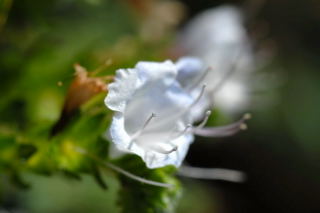
If your plant did survive the winter, chances are that you have found a good spot for it. Let the Echium pininana set seed. Once there is evidence of plenty of ripe seeds (small and black), whack the plant to encourage the seeds to fall. You should find that you have self seeded plants popping up for years to come. Collect plenty of seeds for yourself as well.
.
Growing Echium Pininana from seed
Growing Echium pininana from seed could not be easier. For your first plants you will need to buy the seeds. These are widely available. Apart from Echium pininana there are several other giant echiums hybrids to choose from. The foliage is similar but the flowers are different colours. Different hardiness is sometimes quoted for various plants but a good frost will wipe out the lot of them.

A nice upright
Echium pininiana
flower stalk
(For a change).
Fill a wide pot with multi-purpose compost. Sterilize with compost with boiling water and allow to cool. When the compost has cooled, surface sow the seeds. Press the seeds in to the compost but do not cover them. Light is important for germination. Plants grown indoors have have failed to germinate. Plants sown in the greenhouse germinate rapidly. Heat is not required for the germination of echiums.
As these plants germinate readily you do not need to get them started too soon. In fact germinating echiums too early can lead to a few problems. It is a good idea to prick out your echiums pininana seedlings as soon as they are big enough to handle. The plants grow rapidly and in the wind free environment of a greenhouse they do not concentrate on building a sturdy stem. The stems of small echiums are quite brittle. If the plants are allowed to race away they can become lanky (not in the etiolated sense) and are susceptible to being snapped easily by careless handling.
Planting Echium pininana
Echiums are best planted at the transition zones between the hardy exotics (plants that remain in the ground all year) and the tender exotics. As Echiums can occasionally survive a winter, you need to consider how they will look during the winter months. If the plants are placed amongst tender exotics, they will be left high and dry once the frost has wiped out the tender plants. This can leave them looking a bit silly. Also in the following spring, if they survive, they will get in the way of your new design. You will need to work round them whilst they flower and set seed. This can lead to conflict with your artistic tendencies.
Placing the echiums at the transition zones between the hardy exotics and the tender exotics allows the echiums to become part of a group. In the winter they will blend better and receive a modicum of protection from the other plants. If they flower they will be less in the way as you prepare for this years planting. The flowering period generally overlaps with planting out the garden and you have to sit and wait for it to finish. Once flowered and with seeds set the plants can be removed and replaced with other echiums, should you desire.
Due to their biennial nature echiums establish themselves quickly in the garden. The more you prepare the soil with home-made compost and composted manure the larger your plants will grow. It is important to give the plants plenty of water during their first few weeks to establish them well. Once established they become reasonably drought tolerant. It is also important to firm the soil well when planting. The plants become quite top heavy and if the soil is too loose they may tumble.
In areas where winter frost are quite severe and death is guaranteed, you can plant them where you like.
Be careful when transplanting your echiums from greenhouse to garden. Carrying a pot sideways, held by the rim, can lead to exclamations such as 'Oh no!' (or equivalent), when you reach the selected planting spot only to find you have a pot with a snapped stem. Hold the pots upright when carrying.
Self seeding Echium pininana
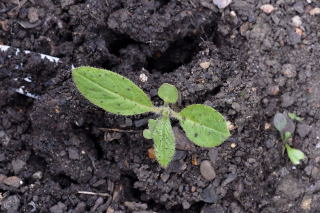
Should your echiums flower, you will be presented with plenty of seed. The seedlings will begin appearing all over the garden. They can easily be transplanted from an inappropriate location to a more suitable area.
.
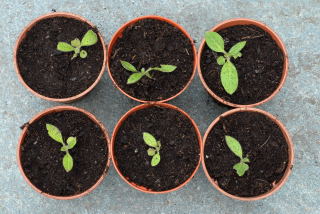
A few echiums gathered up out of harms way. These can be fattened up in the greenhouse and replanted in the soil in a few weeks.
.
One way to increase the amount of self seeded plants is to add the flower spike to the compost heap. As the compost is added to the garden, new plants will keep popping up year after year saving you the need to propagate in the greenhouse. The flower spike can also be put through the garden shredder. The resulting pile of dust can be sprinkled in areas you wish to create colonies. Just rake the soil over in spring and they will do everything else for you.
.

